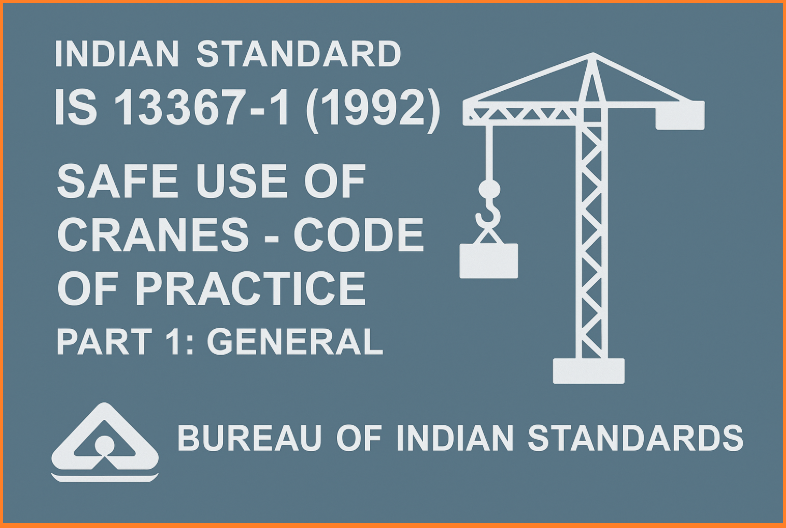Cranes are an essential part of construction, manufacturing, shipyards, and infrastructure projects. However, unsafe use can lead to severe accidents, property damage, and even fatalities. To address these risks, the Bureau of Indian Standards (BIS) introduced IS 13367 (Part 1): 1992, which lays down a comprehensive code of practice for the safe use of cranes.
This article summarizes the key elements of the standard.
Contents
1. Scope
The standard provides guidance for the safe use of all types of cranes, covering:
- Management and planning of lifting operations
- Selection and training of personnel
- Installation, testing, and operation of cranes
- Maintenance and statutory requirements
2. Key Definitions
- Appointed Person: Individual responsible for planning, supervising, and ensuring safe lifting operations.
- Safe Working Load (SWL): Maximum load that a crane can safely handle under specified conditions.
- Automatic Safe Load Indicator (ASLI): Device that warns operators when loads approach or exceed SWL.
- Competent Person: Someone with practical and theoretical knowledge required for crane operations.
3. Management of Lifting Operations
Every lifting operation must be carried out under a safe system of work:
- Adequate planning
- Selection of suitable equipment
- Competent supervision
- Regular inspection and defect reporting
The Appointed Person has the authority to stop unsafe operations.
4. Planning of Lifting Operations
- Simple lifts may require minimal planning.
- Complex lifts (e.g., with obstructions, unusual loads, multiple cranes) require detailed planning, drawings, and written instructions.
- Planning must ensure loads never exceed SWL.
5. Selection & Duties of Personnel
Key personnel include:
- Crane Driver – Operates the crane safely.
- Slinger – Attaches/detaches loads and directs crane movement.
- Signaller – Relays instructions to the driver.
- Erector – Assembles and dismantles cranes.
- Maintenance Personnel – Ensure safe upkeep.
All must be trained, competent, medically fit, and above 18 years (21 years for erectors).
6. Types of Cranes Covered
The code describes safe practices for:
- Mobile cranes
- Tower cranes
- Lorry loaders
- Derrick cranes
- Overhead travelling cranes
- Goliath cranes
- Container handling cranes
- Light cranes and others
7. Safety Requirements
- Personal Protective Equipment (PPE): Helmets, gloves, harnesses, safety shoes, etc.
- Safe System of Work: Prevents inadvertent restoration of power during maintenance.
- Permit to Work: Formal approval before starting critical work.
- Crane Safety Devices: Safe load indicators, limit switches, overload cut-outs, anemometers, fire extinguishers.
- Access & Escape: Safe means for operators and emergency exits must be provided.
8. Siting of Cranes
- Ground must withstand crane loads (including dead weight, load, dynamic forces, wind).
- Avoid proximity hazards like overhead electrical lines, pipelines, public access areas.
- Special precautions are needed near airfields.
9. Erection & Dismantling
- Must be planned and supervised.
- Follow manufacturer’s instructions.
- All components should be identified and properly handled.
- Electrical supply must be safe, with proper earthing and isolation systems.
10. Inspection, Testing & Maintenance
- Daily checks: ropes, brakes, limit switches, fluids, controls.
- Weekly checks: ropes, hooks, structures, safety devices.
- Periodic examinations: by a competent person, with proper records.
- Planned maintenance: lubrication, replacement parts, adherence to manufacturer’s schedule.
11. Operating Conditions
- Never exceed SWL except under supervised testing.
- Avoid swinging loads or side loading on jib.
- Loads should be lifted vertically (no dragging).
- Suspended loads must be monitored continuously.
12. Legal & Documentation Requirements
- Compliance with Factories Act, 1948 and relevant regulations.
- Maintain records of:
- Test certificates
- Inspection reports
- Maintenance history
- Incidents and corrective actions
13. Signalling Systems
- Standard hand signals are prescribed for communication.
- Audio or visual aids (radio, CCTV) can be used when visibility is poor.
- Only one designated person should give signals to the driver.
The IS 13367 (Part 1): 1992 standard is a comprehensive guide for ensuring crane safety. It stresses that safe lifting depends not only on equipment but also on competent personnel, proper planning, and strict supervision.
By following these practices, industries can minimize accidents, safeguard workers, and maintain compliance with statutory laws.





